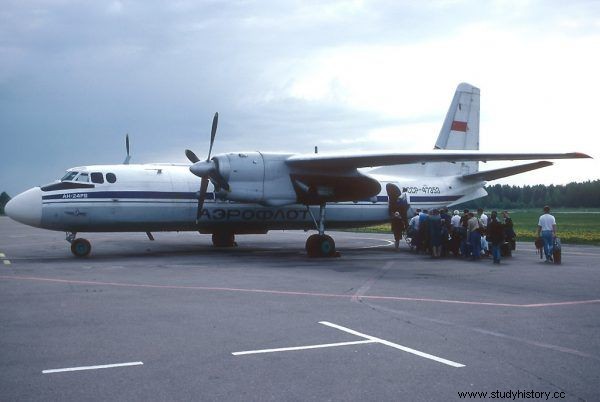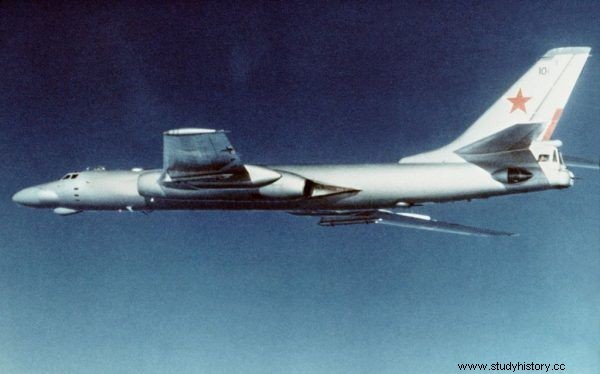On August 24, 1981, a crash occurred near the city of Zawitinsk in the Amur Oblast - the An-24RW passenger plane collided with a Tu-16K bomber at an altitude of over 5,000 meters. Only one person survived the catastrophe:20-year-old Russian Larysa Sawicka. Coincidence? Luck? Or maybe ... a miracle? How did she manage to cheat destiny?
When on August 1981, Larysa, a student of pedagogy, and her newly married husband, 19-year-old Vladimir (Volodya), the future doctor, boarded the plane at the Komsomolsk airport in Amura, nothing foreshadowed the tragedy. The couple was returning home from their honeymoon, to Błagowieszczeńsk. Earlier, the young people visited Larysa's relatives in Vladivostok and the Volodya family in Komsomolsk.

Larysa Sawicka with her husband Wołodia
There were 32 people on board An-24RW:5 crew members and 27 passengers (26 adults and 1 child). As Sawicka recalled years later, when getting in, the flight attendant asked her and her husband to take seats in the front, but Larysa - for reasons she did not understand - sat in the back . Volodya followed her. The girl was very tired because their flight was delayed by 4 hours due to bad weather conditions, so she fell asleep quickly. An-24RW started at 13:56 local time.
Piling Bugs
A few hours earlier, at 8:00 a.m., the controllers started their next duty at the air traffic control tower in Archara. A dozen or so minutes later they were informed that on that day there would be military planes in their zone at an altitude of 4,200-4,500 meters on that day at 9:00 am, 2:00 pm and 7:00 pm.

The passenger plane An-24RW
At 2:57 pm, the An-24RW crew received clearance from the tower in Archar to fly on the Moscow - Khabarovsk route at an altitude of 5,400 meters. The inspectors ignored the fact that the passenger plane had deviated from its course by some 125 kilometers. Meanwhile, at 15:01 the same turret was contacted by the crews of two military Tu-16K machines (one with call sign 07034 and the other - 07514) flying at a predetermined altitude. The captains asked for permission to increase the altitude to 7800-8100 meters. And they got them.
The problem is that it was connected with the crossing of the Moscow-Khabarovsk route. However, the tower apparently "forgot" that the An-24RW was supposed to be in the same airspace at the same time. The result of this neglect was tragic. One of the Tu-16K (call sign 07514) collided with a passenger plane in the air.
Hell on board
Larysa Sawicka woke up when a bomber struck the "annuszka" (as An-y was affectionately called). She later recalled:
There were screams in the lounge, some passengers just howled. I looked at Volodya. His face was covered in blood, so I realized he was dead .
As the plane began to descend, Larysa fell from her seat into the aisle. She passed out for a moment. When she woke up, she remembered a scene from an Italian movie in which the protagonist survived an airplane crash, clinging to an airplane seat. So the woman crawled over to the armchair by the window and grabbed the armrests.

Military aircraft Tu-16K
As improbable as it may seem, this cinematic "trick" saved her life. According to Rudolf Tejmurazov, an expert from the Interstate Aviation Committee who investigated about 150 disasters:
In this case the rear part of the living room acted like a parachute, thanks to which Sawicka did not fall like a stone . The girl also saved herself thanks to the fact that she was pressed into the armchair and clung to the armrests.
In addition, the wreck fell on a birch tree, which - according to Tejmurazov - "softened the hard landing". After the collision with the ground, Sawicka - as she recalled - “felt pain in every cell of her body” and she lost consciousness. But she was alive.
A miracle in the taiga
Finally she woke up - it was after 8 PM. Larysa had a gift from her husband who helped to determine the hour - a gilded watch, which miraculously survived the catastrophe, just like her. She shouted, "Are there any living people here?" Silence answered her. In front of the seat was the bloody body of Volodya.
It started raining; in the taiga in August the temperature is around 8-10 degrees. The girl was freezing because she was wearing only a knitted dress and a raincoat. Her back and chest ached excruciatingly (then Larysa did not know yet that her spine was broken in five places). She tried to discern her immediate surroundings. She found a puddle and drank from it, then returned to the chair. "I couldn't sleep," she recalled years later. - "I felt an emptiness inside and dreamed of death."
It was still raining the next day. Sawicka huddled in the chair. Finally, on August 26, she noticed planes and helicopters searching the area. To attract the attention of the pilots, the girl began waving a red rag at them. But no one came to get her - it never occurred to anyone that someone might have survived the catastrophe. In addition, there were several groups of geologists working in the taiga at that time, so the pilots thought that one of the scientists was giving them the signals.

At night the temperature dropped to 8-10 degrees
Larysa almost lost all hope of rescue. However, a few hours later, she was finally found by soldiers who were combing the taiga, collecting the remains of the victims scattered for several kilometers. When the military saw the girl, they were speechless. As she found out after some time, she had a grave ready - the graves were dug according to the An-24RW passenger list.
When Sawicka realized that help had come, her legs refused to obey. The adrenaline that made survival possible stopped working. The woman was transported to the district hospital in Zawitin. The doctors there overlooked spine fractures. They focused on other injuries:besides, Larysa had a severe concussion and jaw injuries.
Years later, due to medical errors, Sawicka suffered from partial paralysis of the lower and upper limbs. Even so, she did not qualify for a disability class, which would have given her the right to receive free medication…
Aftermath of the accident
As military planes participated in this tragic event, the information about the crash was not made public. And since the collision did not officially take place, Larisa was considered ... a witness to the tragedy, not her victim. She was paid a compensation of 75 rubles.
However, it was not the end of the absurdities. The reports of the accident made their way to the Western media. In order to silence the rumors and cover up the whole matter, the sports newspaper "Sovetsky sport" wrote about Sawicka. The subject of the article was the alleged flight of a woman on ... a self-constructed paraglider.
The truth about the catastrophe was declassified only in post-Soviet times. Currently, director Dmitry Suvorov is making a fictional film about the miraculous saving of Larysa Sawicka, called "Odna".
